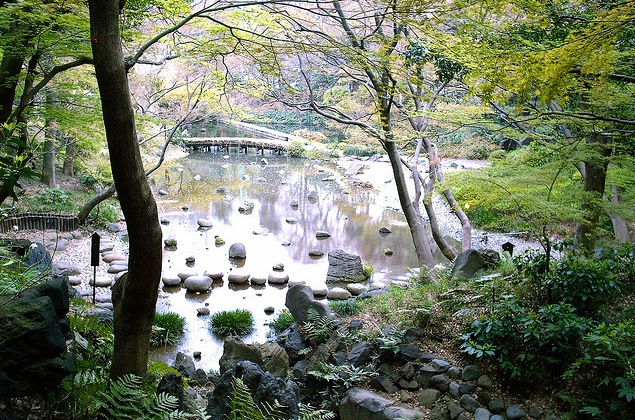by Judith Clancy
At the bottom of a basin surrounded by 800 m (2,400 ft.) mountains on three sides and traversed by three rivers that extend to the Inland Sea and, eventually, the Pacific Ocean is Kyoto, Japan’s ancient capital and today the site some of its finest architecture and gardens.
Nearby forests initially provided the timber for the first Buddhist temples, aristocrats’ estates and commoners’ homes. By the 17th century, a commercial class had arisen within the city and along with it a unified architectural style of merchant homes known as machiya.
These machiya townhouses are typically long and narrow””since they were taxed according to their street-facing frontage. The very front room was used as a shop, and the family lived in the rooms toward the rear.
Today many of these machiya have been renovated and serve as restaurants offering unhurried, freshly prepared meals in a setting full of appealing architectural details such as earthen clay walls and sturdy wooden posts and beams.
Machiya were residences, so most are small, seating between 10 to 30 people, providing an intimacy not found in fast-food or hotel restaurants. Being long and narrow, they generally rely on an inner garden to bring in natural light and air. These inner gardens may feature just a stone lantern and a single pine tree that reveal the owner’s taste and budget. More spacious gardens will boast large rocks, an indication that the garden predates the residence, since carrying a massive stone through a narrow house corridor would have been impossible.
Source: dreamwks.com via Stone Bridge on Pinterest
When it comes to dining in places where the garden is larger and more prominent, seek out old estates like Korin, near the southeast side of the old Imperial Palace. The food here is light Japanese fare at a very reasonable price. Northwest of Kawaramachi-dori and Marutamachi-dori intersection. Tel: 075-212-3531.
The Garden Oriental (known to locals as Higashiyama Sodo) was the estate of the painter Takeuchi Seiho. The fare here is Italian, and the grounds are spacious. Tucked up at the foot of the Eastern Mountains, near the very popular temple of Kiyomizu, the estate handles wedding parties on the weekends, so its café and restaurant are usually open to the public only on weekdays. 3 blocks east of Higashioji-dori, at end of Nenenomichi. Tel: 075-541-3331.
Another old estate, the flagship for a restaurant chain, Ganko serves very elegant””and expensive”” kaiseki cuisine (multiple courses of traditional Japanese food). An a la carte menu is also available. The garden is for strolling, with paths wending around a small pond and up a manmade hill upon which a tiny pavilion sits. Spotlighted at night, the garden draws as many admirers as the restaurant does diners. Located along the Takase River near Nijo-dori and the Kamo River, this area of Kyoto is also an inviting place for a quiet evening walk. East of Kiyamachi-dori, just south of Nijo-dori. Tel: 075-223-3456.
Source: artisansofleisuretraveler.com via Stone Bridge on Pinterest
A strong tendency in much Japanese art is minimalism. This strain is very evident in the garden of Zenkashoin on Muromachi-dori, a little south of Nijo-dori. The café here specializes in a kind of sponge cake introduced by the Portuguese in the 16th century and still cooked in an old-style waffle-like grill. The sweets shop and gallery are open to visitors, so you don’t need to order at the café to admire the space. In the gallery you can see a large post bearing the date on which this 290-year-old structure was constructed. Between the café and gallery is the garden, a square expanse of lawn with a single cherry tree and a single maple. The startling expanse of this open space, particularly in this very downtown location, makes it one of Kyoto’s more unique and little known patches of green. West side of Muromachi-dori, just south of Nijo-dori. Tel: 075-241-3300.
Judith Clancy is a long-time resident of Kyoto, where she has recently been named a Visit Kyoto Ambassador. This article is adapted from Kyoto Machiya Restaurant Guide: Affordable Dining in Traditional Townhouse Spaces (Stone Bridge Press, 2012), available in print and e-book formats.
Featured photo by tie78reu






